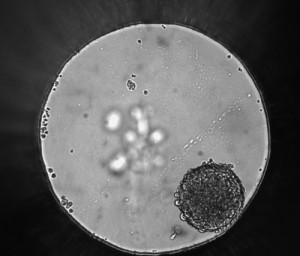
Two cell lines were used: breast cancer epithelial cells (BT-474) and non-transformed breast epithelial cells (MCF-10A). Both were grown in 96-well plates to either encourage monolayer formation (flat-bottom plates) or spheroid formation (round-bottom ultra-low attachment plates). After 48 hours, the cells were treated with compounds from the National Cancer Institute Approved Oncology Drug Collection. This library included compounds like cisplatin and fluorouracil. After the cells were incubated with drug compounds for 48 hours, cytotoxicity was assessed using the CellTiter-Glo® Luminescence Cell Viability Assay, which measure cell viablity by quantifying ATP, a marker of metabolically active cells. A hit was defined as >50% decrease in ATP in compound-treated cells compared to cells treated with vehicle only. Researchers were most interested in compounds that were cytotoxic to both monolayer and 3D cell cultures for BT-474 cells and affected only monolayer MCF-10A cells. Drug compounds that produced hits included ones that targeted EGF receptors (e.g., gefitinib and lapatinib) and a broad-spectrum kinase inhibitor dasatinib. In additional experiments, dose-response testing confirmed that some of the compounds affected BT-474 cells in 3D cell cultures at a low dose (e.g., EC50 <1µM lapatinib) but needed a greater dose to affect MCF-10A cells (EC50 = 9.8µM lapatinib), demonstrating a greater selectivity for breast cancer cells. Other drug compounds that seemed promising in the first screen did not show strong selectivity in the dose-response assay. The researchers acknowledged that they were starting with a biased compound library known to work against breast cancer cells. However, their experiments demonstrated that 3D cell culture could be used to screen compounds in a 96-well plate.
To determine the effects of test compounds in a system that more closely mimics a tumor, Howes et al. cocultured tumor cells with fibroblasts and endothelial cells in both 2D and 3D culture and compared the responses to the same NCI Approved Oncology Drug Collection to the responses of 2D and 3D cocultures of fibroblasts and endothelial cells. The cocultured cells were exposed to four concentrations of the drugs (100, 10, 1 and 0.1µM), and hits were defined as <50% viability at any of the four concentrations tested, a low threshold that identified most of the same compounds found in the first screening with only BT-474 cells. By assessing the EC50 values for these hits, the researchers identified cytotoxic compounds that had a preferential effect on 3D tumor cocultures compared to the normal cell cocultures, yielding 12 compounds that targeted receptor tyrosine kinases or microtubules. In a secondary concentration-response assay on these 12 compounds, the microtubule inhibitors were more toxic to the tumor cell 3D cocultures than the fibroblasts and endothelial cell 3D coculture. However, in 2D cocultures, the microtubule inhibitors were cytotoxic to both tumor and normal cells and lacked specificity for tumor cells. Lapatinib, a tyrosine kinase inhibitor, showed similar results. That is, under 2D culture conditions, there was little difference in the response between normal and tumor cells. However, for 3D culture conditions, lapatinib had a 30-fold greater effect on tumor cells. To confirm that the BT-474 cells were preferentially affected, 3D spheroids of BT-474 cells, endothelial cells and fibroblasts + endothelial cocultures were exposed to the drug and the results compared. The tumor cells demonstrated the greatest sensitivity to the drug while the normal cells were one or two orders of magnitude less sensitive.
Previous studies on 2D and 3D cultures in tumor cells suggested that the expression of epidermal growth factor receptor (EGFR) and human epidermal growth factor receptor 2 (HER2) was altered. Because lapatinib affects both these pathways, researchers decided to look at EGRF and HER2 expression and phosphorylation in their 2D and 3D model systems. BT-474 cells, BT-474 + fibroblast + endothelial cells and fibroblast + endothelial cells were cultured both as 2D and 3D cultures for 72 hours. Cells were lysed and proteins were analyzed by Western blot using antibodes for phosphorylated and total EGRF and HER2. For EGFR, phosphorylation decreased in 3D cultures compared to 2D cultures. For the cocultures, the overall expression of EGRF was higher compared to BT-474 cells alone with no increase in phosphorylation in 2D versus 3D cultures. To better examine what might be happening with the cells in context, cells were immunostained for phosphorylated EGRF. Cells in 3D cultures had phosphorylated EGRF only on the outside of the spheroid, whereas the 2D cultured cells were all stained for phosphorylated EFGF.
Similar results were seen for HER2. As determined by Western blotting, normal cells lacked any expression of HER2, total expression of HER2 was reduced in 3D cultures and phosphorylated HER2 was expressed strongly in 2D-cultured cells. In immunostaining experiments, 3D cultures were only stained for phosphorylated HER2 on the spheroid surface; nearly all of the 2D cultured cells were stained for phosphorylated HER2. These results suggest that receptor expression and phosphorylation are two of the mechanistic differences between monolayer cell culture and 3D spheroids.
In this study, scientists developed a model system for high-throughput screen of potential anti-cancer compounds and address some of the limitations of monolayer cell culture. Using 3D coculture to more closely mimic the tumor microenvironment, researchers demonstrated a greater sensitivity to compounds compared to normal cells in coculture spheroids. The authors admit this is a proof-of-concept and selected a compound library specifically targeting breast cancer cells. Further testing using a larger library would help determine if this strategy is one that can used to better screen potential cancer drugs.
Reference
Howes, A.L., Finlay, D. and Vuori, K. (2014) 3-Dimensional Culture Systems for Anti-Cancer Compound Profiling and High-Throughput Screening Reveal Increases in EGFR Inhibitor-Mediated Cytotoxicity Compared to Monolayer Culture Systems, PLOS ONE, 9 (9) e108283. DOI: http://dx.doi.org/10.1371/journal.pone.0108283
Sara Klink
Latest posts by Sara Klink (see all)
- A One-Two Punch to Knock Out HIV - September 28, 2021
- Toxicity Studies in Organoid Models: Developing an Alternative to Animal Testing - June 10, 2021
- Herd Immunity: What the Flock Are You Talking About? - May 10, 2021
